It started with a burning sensation at the back of my neck going down to the upper thoracic vertebrae. The sensation came and went after long days in the OR, and it helped when I took a hot shower or lied down. A plain cervical spine film showed degenerative changes without a significant disc protrusion.
Over five years this progressed to pain. Door cervical traction, cervical pillows, hot compresses, and several cervical epidurals provided varying degrees of relief. Until one day, the first digit of my left hand went numb and intense pain in the arm kept me up at night. The neurosurgeon warned me that he could deal with the “culprit level” but that the degeneration was occurring at multiple levels. This led to a C4-C5 laminectomy and fusion. Like a true surgeon, I tried to return to full-time work four weeks later, first in the office and then in the OR. I finally admitted defeat when, a couple of months later, I realized I simply could not do major arterial or abdominal work. It frightened me to think that I might have to shorten procedures. How many times could I call on my partners to help me finish a long case?
Over time, the situation worsened to the point that carrying even the smallest item in my white coat for more than 10 minutes would trigger more pain. Ultimately, performing sclerotherapy or ablations on patients while being forced to tilt my head in different positions became too much. My entire career path had to change.
Since then, several of my surgeon colleagues have had laminectomies as well.
Back then, few people were talking about musculoskeletal pain for vascular surgeons. Though we did hear about ergonomic issues with vascular sonographers, we paid little attention to table height, head or body position, or anti-fatigue floor mats and other ergonomic preventive maneuvers.
What I did do right was to pay for and maintain an individual long-term disability insurance policy with a solid company for 20 years. Short-term disability policies (90 days) are commonly provided by employers, but not so much long-term policies. Though group disability policies are good, they alone will not cover your loss of income. And the benefits are taxable, since premiums are deducted by the employer as a business expense.
I am not an expert in disability insurance so you may want to talk to one should the need arise. However, my advice to younger colleagues is to get an individual policy with a solid company, because musculoskeletal problems do arise and collectively are the No. 1 reason for disability claims.
When considering different policies, review the Better Business Bureau or ratings companies like AM Best that assess insurance companies based on consumer feedback. Their ratings typically range from superior (A++, A+) to poor (D, F). It’s also important to investigate how long the waiting period is before benefits become payable to you, for how long the benefit will be paid, whether the premium is waived if you are disabled, and if there is a death benefit. The policy should also be noncancelable, have a few guaranteed renewable periods (called a future benefit option) that do not require a physician examination, and specifically target your “own occupation” and medical specialty. You should also consider a rider for cost-of-living adjustment, even though it will raise your premiums.
These days, insurers selling policies for a specific medical specialty seem to be getting cold feet due to a rash of claims, but there are several companies still willing to write them. Chances are that they will mark disabilities from musculoskeletal disorders as “residual” disabilities — which refers to disabilities you are still able to work with but that cause a loss exceeding 20% of your income — rather than “total” disabilities. No insurer will replace 100% of your income loss for the entire duration of your policy.
If you are a resident or fellow, you may already be receiving many cold calls or emails from agents. Pay attention to their offers and check the company’s reputation before moving forward. You are many times more likely to be disabled than die at a young age. Get a policy early, and make sure you have several guaranteed opportunities to adjust it over time as your income rises and/or your family situation changes. It will probably hurt to have to pay six monthly premiums using after-tax dollars but do it anyway. This way, any benefits you receive will be tax-free.
There is still a need for more research into the best ways to prevent physical harm when working in the OR. The best advice I can offer for now is to pay attention to early warning signs, modify your workplace as needed, and arm yourself with the best disability policy you can afford.
What steps have helped you preserve, if not prolong, your career as a surgeon? Share your experiences in the comment section.
Bhagwan Satiani, MD, MBA, FACHE (R), FACS, is Professor of Surgery Emeritus at The Ohio State University College of Medicine in Columbus, Ohio. He blogs at www.savvy-medicine.com, on Twitter #savvymed, and on LinkedIn.
Illustration by April Brust







